- Home
- »
- Medical Devices
- »
-
Ophthalmic Devices Market Size And Share Report, 2030GVR Report cover
![Ophthalmic Devices Market Size, Share & Trends Report]()
Ophthalmic Devices Market Size, Share & Trends Analysis Report By Product (OCT, Ophthalmic Ultrasound Imaging Systems), By Application (Cataract, Glaucoma), By End-use, By Region, And Segment Forecasts, 2024 - 2030
- Report ID: 978-1-68038-901-2
- Number of Report Pages: 140
- Format: PDF, Horizon Databook
- Historical Range: 2018 - 2022
- Forecast Period: 2024 - 2030
- Industry: Healthcare
Ophthalmic Devices Market Size & Trends
The global ophthalmic devices market size was estimated at USD 7.0 billion in 2023 and is anticipated to grow at a compound annual growth rate (CAGR) of 4.92% from 2024 to 2030. The growth of the market can be attributed to the rising prevalence of optical disorders, such as glaucoma, cataract, diabetic retinopathy, and vitreoretinal disorders, coupled with technological advancements in ophthalmic surgical as well as diagnostic instruments required for these target applications. Improved government initiatives to increase awareness related to visual impairment are further anticipated to widen the base for market growth.
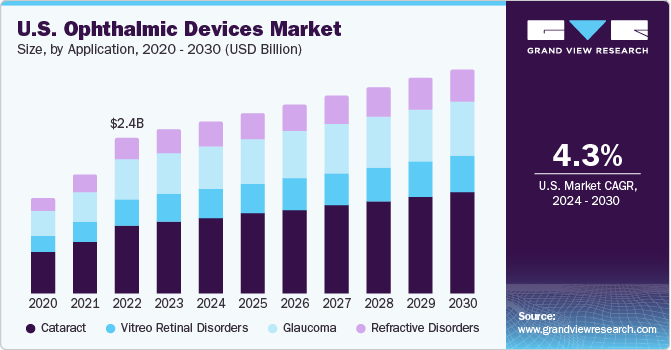
The growing geriatric population is increasing the demand for ophthalmic devices, as they are more susceptible to age-related ophthalmic disorders. According to the National Institute on Aging (NIA), the geriatric population is expected to reach around 72 million by 2030. The increasing prevalence of diabetes and the incidence of diabetes-related blindness are predicted to fuel market growth. According to the World Health Organization, nearly 422 million people worldwide have diabetes, and the majority are living in low- and middle-income countries.
Increased screen time due to the lockdown measures in the COVID-19 pandemic has been associated with the onset and progression of various eye diseases, thus driving the demand for eye examinations. In June 2020, Johnson & Johnson Vision donated USD 320,000 to provide eye care to COVID-19-impacted patients. The organization conducted this donation to the Optometry Cares unit of the American Optometric Association (AOA) Foundation and the American Academy of Optometry Foundation (AAOF).
Technological advancements have enabled accurate diagnosis and improved treatment of ophthalmic disorders. Advancements in medications, diagnostic devices, laser technology, and surgical techniques, have enabled improved handling of cataract & macular degeneration, glaucoma, and dry eye disease. Minimally invasive surgeries, such as LASIK (laser-assisted in situ keratomileusis) surgery, multi-wavelength diabetic retinopathy treatment, ultrasound phacoemulsification, and femtosecond laser surgery are expected to increase the demand for ophthalmic devices. These surgeries are accompanied by better outcomes for patients and faster recovery rates.
Many organizations have conducted campaigns and programs to raise awareness for eye health and vision care among the public, optometrists, and ophthalmologists for diagnosis and treatment of ophthalmic problems. In addition, several suppliers also offer hands-on training for ophthalmologists and technicians about how to use various ophthalmic equipment through courses, tutorials, and workshops.
Market players are also coming up with advanced products to meet the demand. For instance, in April 2023, Bausch & Lomb announced the launch of ophthalmic viscosurgical devices in the United States. In March 2023, WaveFront Dynamics Inc. announced the commercial launch of its WaveDyn vision Analyzer. Such initiatives help increase awareness about eye diseases and availability of diagnostic equipment.
Market Concentration & Characteristics
The market growth stage is high and the growth pace is accelerating. Technological advancements, increasing demand from emerging economies, and growing awareness about eye health are likely to fuel market expansion. Rising disposable incomes and improving healthcare infrastructure in developing economies like China and India create significant growth opportunities.Government programs promoting eye care and vision correction in regions like North America and Europe contribute to the expansion of global market for ophthalmic devices.
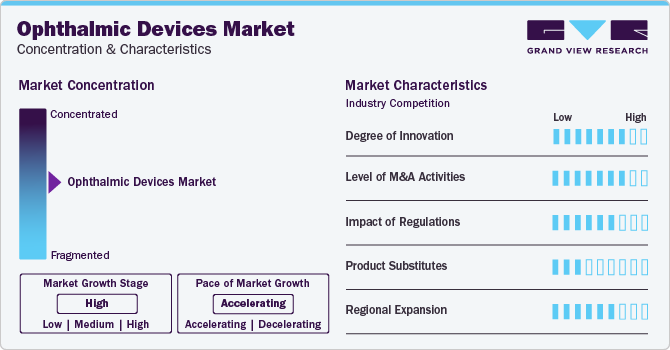
Key strategies implemented by major players in the ophthalmic devices market are new product launches, expansion, acquisitions, partnerships, and other strategies. In October 2023, researchers from Sweden developed a microscale device, which can be used for implantation in the eye, that states novel opportunities for cell-based treatment of diabetes and other related diseases.
Advancements like phacoemulsification for cataracts and laser-assisted procedures for refractive errors have revolutionized eye surgery, leading to faster recovery times, improved outcomes, and wider patient accessibility. Technological leaps in devices like optical coherence tomography (OCT) and fundus cameras have enabled early-stage and more accurate diagnosis of eye diseases, improving treatment efficacy and preventing vision loss. Such innovations foster growth in this industry.
The impact of M&A activities is variable, with high impact in specific segments like intraocular lenses (IOLs), and surgical devices, and a moderate overall impact in other segments due to the market's diversity. By acquiring competing companies or technologies, businesses can offer a wider range of devices, catering to diverse needs and tapping numerous segments at the same time. Carl Zeiss Meditec AG in December 2023, acquired 100% shares in the Dutch Ophthalmic Research Center from the investment firm Eurazeo SE. Through this acquisition, ZEISS increased its ophthalmic offerings by seamlessly blending its product range with digitally connected solutions for comprehensive vision care across retinal disorders, cataracts, glaucoma, and refractive errors.
Stringent regulations ensure rigorous testing and approval processes for ophthalmic devices, minimizing risks and protecting patient safety. This nurtures trust in the market and encourages widespread acceptance of safe, effective technologies. Regulatory bodies like the FDA in the U.S. and the MHRA in the UK provide transparency in device approval processes and hold manufacturers accountable for product safety and efficacy. This builds trust and promotes ethical practices in the market.
This market is highly fragmented with numerous manufacturers, including large pharmaceutical companies and generic drug suppliers. A diverse range of companies exist in this competitive industry including established brands like CooperVision to smaller players catering to niche segments.
Regional expansion holds immense potential for growth of this market and improved global access to eye care. Focusing on affordability, infrastructure, and access to skilled professionals is crucial to maximize its impact. There is moderate to high impact in regions like APAC and Latin America due to rapid growth.
The optical coherence tomography (OCT) segment dominated the market and accounted for the largest revenue share of more than 23.0% in 2023. OCT produces high-resolution cross-sectional and three-dimensional images of biological microstructure and has major applications in the diagnosis of diseases such as glaucoma, related Macular Degeneration (AMD), and diabetic eye. Technological advancements, such as the integration of OCT with artificial intelligence (AI), are expected to boost the adoption rate of this device among healthcare providers. For instance, in August 2021, Abbott's latest OCT imaging platform, driven by the Ultreon Software, was approved by the FDA. This cutting-edge imaging software combines OCT with AI to give physicians a more complete picture of coronary blood flow and blockages, assisting in decision-making as well as determining the optimum treatment approach.
The ophthalmoscopes segment is anticipated to witness the fastest growth rate from 2024 to 2030. Ophthalmoscopes are used in the diagnosis of diseases such as CMV retinitis, papilledema, glaucoma, AMD, and diabetic retinopathy. In August 2019, Nidek launched the Mirante Scanning Laser Ophthalmoscope. It is a multimodal fundus imaging device, that combines high-resolution Scanning Laser Ophthalmoscopy (SLO) and OCT imaging with ultra-wide field imaging properties. The increasing prevalence and growing demand for accurate and early diagnosis of these diseases are expected to have a positive impact on the market growth.
Application Insights
The cataract segment is expected to witness significant growth from 2024 to 2030. This can be attributed to the high adoption of ophthalmic devices for cataract surgeries. According to the World Health Organization (WHO), cataracts are the leading cause of blindness. Nearly 51% of the total cases of blindness in the world are the result of cataracts. The refractive disorders segment is anticipated to witness the fastest growth rate from 2024 to 2030.
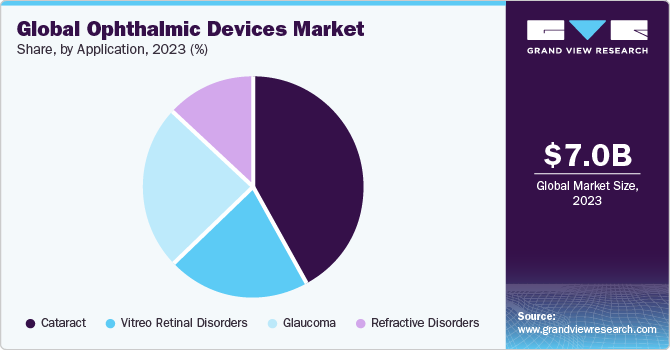
According to the WHO, there are about 2.2 billion people globally who have near or distance vision impairment. To treat such disorders and correct refractive errors, ophthalmic devices, such as phoropters and retinoscopes, are highly preferred. To meet the requirements of the increasing number of patients who need eye care treatment, major market players are focused on introducing advanced ophthalmic diagnosis & treatment devices.
End-use Insights
The hospitals & eye clinics segment held the largest share in 2023 and is expected to continue its dominance over the forecast years. This can be attributed to the increasing adoption of ophthalmic devices in hospitals and low-cost & effective treatment provided in clinics. The increasing mergers and acquisitions between ophthalmic clinics and hospitals are likely to boost the demand for new installations in the upcoming years. In June 2023, Eye-Q announced the installation of a customized and advanced LASIK machine at its Rewari eye-care facility, in India. This machine changed laser vision correction and offered advanced treatment to patients.
Moreover, several eye clinics are now coming up with separate diagnostic departments, which in turn, is boosting the demand for ophthalmic devices. Additionally, the growing number of eye clinics that offer cost-effective treatment is expected to drive the growth of the market from 2024 to 2030. The market for academic & research laboratories is expected to grow at a significant rate from 2024 to 2030. Academic & research laboratories receive funding for ophthalmic care. For instance, John Hopkins Wilmer Eye Institute, U.S., receives large funding from the National Eye Institute to boost ophthalmic research.
Regional Insights
North America held the largest share in 2023. A high population of older adults and rising prevalence of chronic eye conditions resulting from factors, such as high stress and unhealthy lifestyles; ultimately leading to diabetic retinopathy, are considered high-impact rendering drivers for the market. In addition, the incorporation of new reimbursement models for ophthalmologic treatment and a stringent regulatory framework aimed at patients’ safety, is expected to fuel product demand in this region.
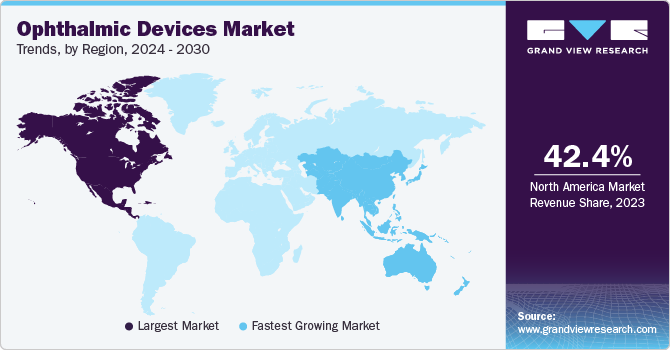
The U.S. possesses a well-developed healthcare system with leading academic institutions and research facilities. This encourages innovations in ophthalmic devices in terms of minimally invasive surgical techniques, advanced diagnostic instruments, and personalized medicine approaches, thereby propelling growth for the U.S. market. The U.S. spends significantly on healthcare compared to other developed countries, with total healthcare spending projected to reach $4.8 trillion by 2030. This translates into increased funding for specialized therapies and devices, including eye care.
Asia Pacific is anticipated to grow at the fastest CAGR from 2024 to 2030. Due to the rapidly improving healthcare infrastructure, rising prevalence of eye disorders, such as glaucoma, and increasing awareness about these disorders. The growth can be attributed to the increasing outsourcing activities for ophthalmology devices by key industry players, such as Alcon, Inc. Moreover, the increasing awareness about advanced corrective vision treatments is a key growth-driving factor for emerging economies, such as China and India.
India's healthcare infrastructure is steadily improving. The establishment of more ophthalmic centers, the availability of skilled professionals, and advancements in technologies like telemedicine across India create lucrative growth for several market players within India. The Indian government’s National Programme for Prevention and Control of Blindness (NPCB) and other initiatives raise awareness about eye health and prioritize access to essential eye care services. These programs drive demand for affordable and effective ophthalmic diagnostic devices.
Key Ophthalmic Devices Company Insights
The success of market strategies depends on adaptability, innovation, and understanding the specific needs of different customer segments. Large companies leverage their resources and brand power, while smaller players can carve out niches through specialization, cost-effectiveness, and disruptive technologies. By keeping track of emerging trends and continuously adapting strategies, all players can contribute to driving market growth and improving eye care globally. Large-scale companies are investing in R&D for several devices, particularly in areas like IOLs, laser systems, and advanced diagnostic instruments. These companies are also focusing on their brand image and distribution networks to maintain market share and enter new markets.
Key Ophthalmic Devices Companies:
The following are the leading companies in the ophthalmic devices market. These companies collectively hold the largest market share and dictate industry trends. Financials, strategy maps & products of these ophthalmic devices companies are analyzed to map the supply network.
- Johnson & Johnson Vision Care
- Alcon Vision LLC
- Carl Zeiss Meditec AG
- Bausch & Lomb Incorporated
- Essilor International S.A
- Ziemer Ophthalmic Systems Ltd
- Nidek Co. Ltd
- TOPCON Corporation
- Haag-Streit Group
Recent Developments
-
In August 2023, Johnson & Johnson Vision presented its Elita laser correction device in the U.S. launch. This platform offers a revolutionary way to correct short-sightedness through a minimally invasive laser-assisted lens removal procedure
-
In July 2023, Alkem Laboratories announced its entry into the Ophthalmology field with the launch of a massive portfolio of quality and affordable eye care products. This launch of Alkem’s ophthalmic product confirms that patients in India have access to quality eye care formulations at an affordable price
-
In June 2023, Bausch + Lomb Corporation launched INFUSE Multifocal silicone hydrogel (SiHy) daily disposable contact lenses across the U.S. These new daily disposable lenses keep patient’s eyes comfortable and dry-free
-
In April 2023, Bausch + Lomb launched the TotalVisc viscoelastic system and StableVisc cohesive ophthalmic viscosurgical device. These products offer eye surgeons with novel options for dual-action protection during cataract surgery. This strategy helped in expanding its product portfolio
Ophthalmic Devices Market Report Scope
Report Attribute
Details
Market size value in 2024
USD 7.37 billion
Revenue forecast in 2030
USD 9.79 billion
Growth rate
CAGR of 4.92% from 2024 to 2030
Actual data
2018 - 2023
Forecast period
2024 - 2030
Report updated
January 2024
Quantitative units
Revenue in USD million and CAGR from 2024 to 2030
Report coverage
Revenue forecast, company ranking, competitive landscape, growth factors, and trends
Segments covered
Product, application, end-use, region
Regional scope
North America; Europe; Asia Pacific; Latin America; MEA
Country scope
U.S.; Canada; UK; Germany; Italy; France; Spain; Denmark; Sweden; Norway; Japan; China; India; South Korea; Australia; Thailand; Brazil; Mexico; Argentina; South Africa; Saudi Arabia; UAE; Kuwait
Key companies profiled
Johnson & Johnson Vision Care; Alcon Vision LLC;Carl Zeiss Meditec AG; Bausch & Lomb Incorporated; Essilor International S.A; Ziemer Ophthalmic Systems Ltd; Nidek Co. Ltd; TOPCON Co.; Haag-Streit Group
Customization scope
Free report customization (equivalent up to 8 analyst’s working days) with purchase. Addition or alteration to country, regional, and segment scope
Pricing and purchase options
Avail customized purchase options to meet your exact research needs. Explore purchase options
Global Ophthalmic Devices Market Report Segmentation
This report forecasts revenue growth at global, regional, and country levels and provides an analysis of the latest trends in each of the sub-segments from 2018 to 2030. For this study, Grand View Research has segmented the ophthalmic devices market report on the basis of product, application, end-use, and region:
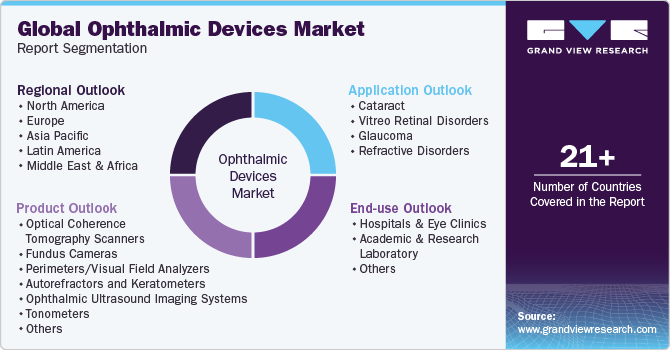
-
Product Outlook (Revenue, USD Million, 2018 - 2030)
-
Optical Coherence Tomography Scanners
-
Fundus Cameras
-
Perimeters/Visual Field Analysers
-
Autorefractors and Keratometers
-
Ophthalmic Ultrasound Imaging Systems
-
Ophthalmic A-Scan Ultrasound
-
Ophthalmic B-Scan Ultrasound
-
Ophthalmic Ultrasound Biomicroscopes
-
Ophthalmic Pachymeters
-
-
Tonometers
-
Slit Lamps
-
Phoropters
-
Wavefront Aberrometers
-
Optical Biometry Systems
-
Ophthalmoscopes
-
Lensmeters
-
Corneal Topography Systems
-
Specular Microscopes
-
Retinoscopes
-
-
Application Outlook (Revenue, USD Million, 2018 - 2030)
-
Cataract
-
Vitreo Retinal Disorders
-
Glaucoma
-
Refractor Disorders
-
-
End-use Outlook (Revenue, USD Million, 2018 - 2030)
-
Hospitals & Eye Clinics
-
Academic & Research Laboratory
-
Others
-
-
Regional Outlook (Revenue, USD Million, 2018 - 2030)
-
North America
-
U.S.
-
Canada
-
-
Europe
-
U.K.
-
Germany
-
France
-
Italy
-
Spain
-
Denmark
-
Sweden
-
Norway
-
-
Asia Pacific
-
Japan
-
China
-
India
-
Australia
-
South Korea
-
Thailand
-
-
Latin America
-
Brazil
-
Mexico
-
Argentina
-
Colombia
-
-
Middle East and Africa (MEA)
-
South Africa
-
Saudi Arabia
-
UAE
-
Kuwait
-
-
Frequently Asked Questions About This Report
b. The global ophthalmic devices market size was estimated at USD 7.0 billion in 2023 and is expected to reach USD 7.37 billion in 2024.
b. The global ophthalmic devices market is expected to grow at a compound annual growth rate of 4.9% from 2024 to 2030 to reach USD 9.79 billion by 2030.
b. North America dominated the ophthalmic devices market with a share of 42.4% in 2023. This is attributable to advancements in ophthalmic devices, which help in the efficient diagnosis and treatment of retinal disorders, glaucoma, and other ophthalmic disorders.
b. Some key players operating in the ophthalmic devices market include Abbott Medical Optics, Inc., Carl Zeiss Meditec AG, Alcon, Inc., Bausch & Lomb, Inc., Haag-Streit, Topcon Corporation, Johnson & Johnson, Essilor International S.A., Ziemer Ophthalmic Systems AG, and Nidek Co. Ltd.
b. Key factors that are driving the ophthalmic devices market growth include the rising prevalence of eye diseases, technological advancements in ophthalmic devices, and government initiatives for increasing awareness regarding visual impairment.
Share this report with your colleague or friend.
![gvr icn]()
NEED A CUSTOM REPORT?
We can customize every report - free of charge - including purchasing stand-alone sections or country-level reports, as well as offer affordable discounts for start-ups & universities. Contact us now
![Certified Icon]()
We are GDPR and CCPA compliant! Your transaction & personal information is safe and secure. For more details, please read our privacy policy.
We are committed towards customer satisfaction, and quality service.
"The quality of research they have done for us has been excellent."





